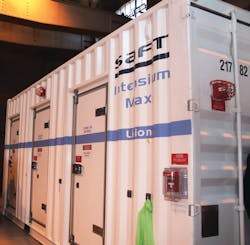As Southeastern Pennsylvania Transportation Authority (SEPTA) leaders have looked for ways to run fiscally leaner, sustainability has been a big focus.
One sustainability project that has garnered international acclaim is the installation of a giant battery within one of SEPTA’s electrical substations to catch regenerative braking energy from a rail line and feed the energy back into the system. The agency has partnered with smart grid firm PJM Interconnection, which purchases the energy in order to stabilize its grid.
Two more similar batteries are now being planned by SEPTA, one of which agency General Manager Joseph Casey said is in procurement. And with 30 substations owned by the agency, SEPTA Strategy and Sustainability Planner Erik Johanson said there’s a huge potential for savings.
“It’s a couple hundred thousand per year. That actually makes the battery cost effective where before just relying on the battery it was barely a break even scenario,” he said. “Now it’s potentially feasible to do it at multiple substations.”
Andrew Gillespie, chief engineer of the engineering, maintenance and construction division of SEPTA, said the energy storage unit works similar to the battery in a Toyota Prius in order to capture the power and feed it back into the catenary system. After installing the system, Gillespie said the agency discovered the system caught a lot more regenerative power than expected, so it has reduced substation electric bills by about 10 percent.
Jacques Poulin, product manager of energy storage in rail transportation for ABB, which was involved in creation of the unit, said although regenerative braking has been around for roughly 20 years, the concept of trying to capture wasted electricity has only been discussed for about the last seven years. By capturing the energy and reusing it for trains still wastes about half of the captured energy, so reselling it to electric companies reduces the waste and the business model with Veridity Energy benefitted both the system and electric company.
He said the substation project remains unique in the world.
“The transit industry is keenly interested in improving its energy or carbon footprint for obvious reasons,” he said. “There is public concern and they’re trying to compete against the car, so they point out that it’s greener to take public transportation and projects like this help improve that image and clearly draw attention to it.”
With the success of the system, Gillespie said SEPTA wrote a competitive Transit Investment in Greenhouse Gas and Energy Reduction (TIGGER) grant to build a second unit at another substation, which will use super capacitors, which could double the life of the unit.
“So with that investment of $2 million, it now has a 20-year life any I’m paying it back in five to seven years,” he said. “I just tripled my payback to SEPTA.”
Although SEPTA could install the units at all 33 of its substations, Gillespie said it’s not economically feasible due to the initial costs and the law of returns. However, there are 10 substations that could be a good first tier for this type of project.
“It has big promise so it has gotten a lot of attention,” he said.
Poulin said the system does capture the majority of energy, but not all of it, saying it’s not recommended because there comes a point where to get to zero waste of energy you have to over-dimension the system, which makes it regressively profitable.
“You’re still capturing 90 percent of the surplus braking energy and you get a much better return than trying to capture that last 10 percent,” he said.
About the Author
Joe Petrie
Associate Editor
I came to Mass Transit in 2013 after spending seven years on the daily newsbeat in southeastern Wisconsin.
Based in Milwaukee, I worked as a daily newspaper reporter with the Waukesha Freeman from 2006-2011, where I covered education, county and state government. I went on to cover courts for Patch.com, where I was the main courts reporter in the Metro Milwaukee cluster of websites.
I’ve won multiple awards during the course of my career and have covered some of the biggest political events in the past decade and have appeared on national programs.
Having covered local government and social issues, I discovered the importance of transit and the impact it can have on communities when implemented, supported and funded.

